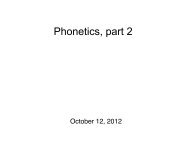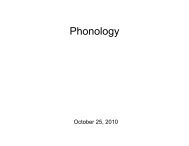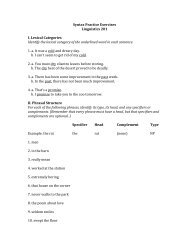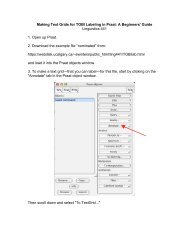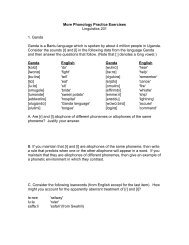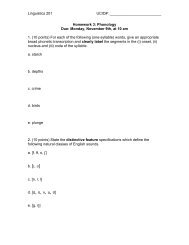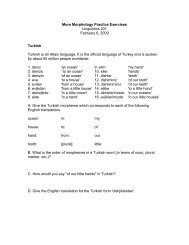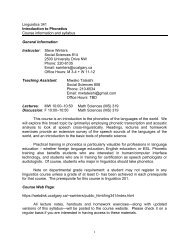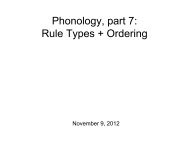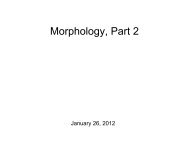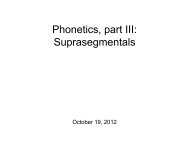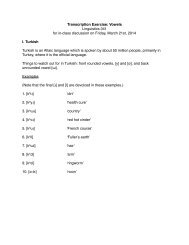Phonology, part 6: Syllables and Phonotactics - Basesproduced.com
Phonology, part 6: Syllables and Phonotactics - Basesproduced.com
Phonology, part 6: Syllables and Phonotactics - Basesproduced.com
Create successful ePaper yourself
Turn your PDF publications into a flip-book with our unique Google optimized e-Paper software.
<strong>Phonology</strong>, <strong>part</strong> 6:<strong>Syllables</strong> <strong>and</strong> <strong>Phonotactics</strong>November 7, 2012
The Road Ahead• Let’s go back to the practice exercises from last class…• <strong>Phonology</strong> Homework: still due on the Wednesday afterthe break (November 14 th ).• I’ll try to get it out by tonight.
And now for something<strong>com</strong>pletely different.• A (very) long time ago…• I talked about the fact that there are some strings of(English) sounds which don’t sound like they couldpossibly be English words.• Possible English words:• plab forch beeg shump staz hibber crong trab• Unpossible English words:• fmort glsik rmak msile vlash zpin ngotch ptud• The unpossible English words violate what are calledthe phonotactic rules of the language.
Sonority <strong>and</strong> <strong>Syllables</strong>• <strong>Syllables</strong> are generally organized around a phonologicalproperty called sonority.• basically: sonority = perceived loudness• Sonorants (vowels, liquids, nasals, glides) have lots ofsonority;• obstruents (stops <strong>and</strong> fricatives) have less.• Basic idea: the most sonorous segments in a syllable formthe “peak” or nucleus of the syllable.• vowels make good peaks;• sonorant consonants are second-best;• obstruents are really bad…
For Example• [bæd] is a well-formed syllable in English.[æ]high sonority[b] [d]low sonority
Sonority <strong>and</strong> <strong>Syllables</strong>• [blænd] works well, too.[æ]high sonority[l] [n][b] [d]low sonority
Technical Termssonority peak[æ]high sonority[l] [n][b] [d]low sonority
Technical Terms• The sonority peak forms the nucleus of the syllable.nucleus[æ]high sonority[l] [n][b] [d]low sonority
Technical Terms• The sonority peak forms the nucleus of the syllable.• The sounds that precede the nucleus form the syllable onset.onset[æ]high sonority[l] [n][b] [d]low sonority
Technical Terms• The sonority peak forms the nucleus of the syllable.• The sounds that precede the nucleus form the syllable onset.• The sounds that follow the nucleus form the syllable coda.coda[æ]high sonority[l] [n][b] [d]low sonority
Technical Terms• The sonority peak forms the nucleus of the syllable.• The sounds that precede the nucleus form the syllable onset.• The sounds that follow the nucleus form the syllable coda.• Together, the nucleus <strong>and</strong> coda form the syllable rhyme.rhyme[æ]high sonority[l] [n][b] [d]low sonority
Syllable Formation• In order to figure out how to organize a word intosyllables, first identify the syllable nuclei• = vowels <strong>and</strong> any syllabic consonants• Example: “America”σ σ σ σN O N O N O N[ʌ m ɛ r ɪ k ʌ]• Then identify any potential onsets to each syllable• = consonants preceding the nuclei
<strong>Phonotactics</strong>• Phonotactic constraints determine what sounds can beput together to form the different <strong>part</strong>s of a syllable in alanguage.• Ex: English onsets/kl/ is okay: “clean” “clamp”/pl/ is okay: “play” “plaque”*/tl/ is not okay: *tlay *tlamp• If we ever encounter a word that starts with /tl/, we haveto do something about it.• How do you say “Tlingit”?• Or “Dmitri”?
Let’s Try Another…σNσC O N C “arcade”[a r k e j d]Note 1: both halves of a diphthong <strong>com</strong>bine into onenucleusNote 2: [rk] is not a possible onset!⇒ The [r] has to form the coda of the precedingsyllableSo, Step 3 = remaining consonants go into codas.
The Possibilities are notEndless• Q: What <strong>com</strong>bination of consonants can form a possibleonset?• A: Any <strong>com</strong>bo that can be found at the beginning of aword.• [θr] can start a word (“three”), so “arthritic” is syllabifiedlike this:σ σ σN C O N O NC[a r θ r ɪ t ɪ k]
The Possibilities are notEndless• [tl] <strong>and</strong> [nt] cannot start words (in English), so theycannot form legal syllable onsets.• Check out the syllabification for “Atlantic”:σ σ σN C O N C O N C[ɛ t l æ n t ɪ k]
Interesting Patterns• Check out the following words:AtlanticAmericaatrociousarcadeastronomy arthritic• When is the first vowel a [ʌ]?• Is there a difference between the /t/ in ‘atrocious’ <strong>and</strong>the /t/ in ‘Atlantic’?• Why?
The Last Quick Write
The Last Quick Write
Other Languages• Phonotactic constraints may be<strong>com</strong>e active when wordscross language boundaries• In Spanish, the following consonant clusters cannot starta syllable or a word:*/sp/*/st/*/sk/• Example Spanish pronunciation of English:• “student” →
Sound Substitution• In borrowings, languages often substitute native soundsfor non-native sounds• They may also break up sound sequences to satisfynative phonotactics.• Example:English “birth control”Japanese:• Or Hawaiian: [mele kelikimaka] for “Merry Christmas”



